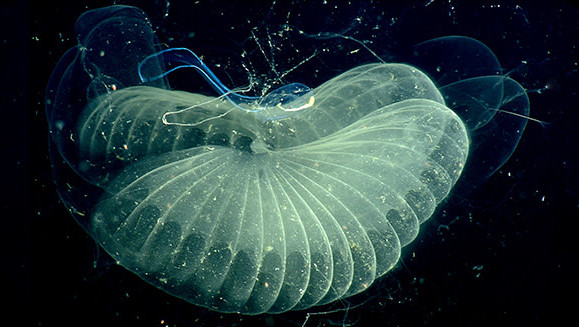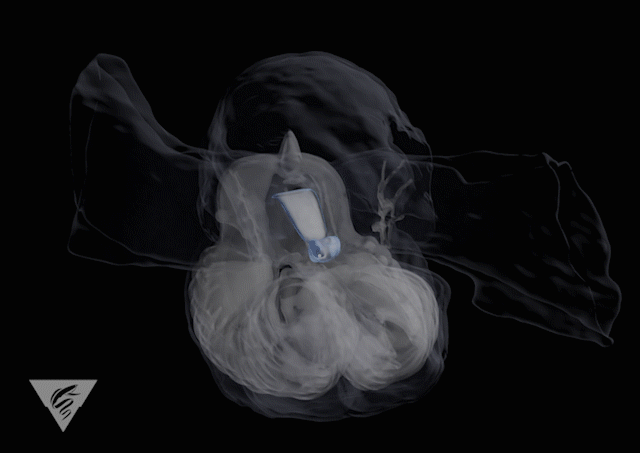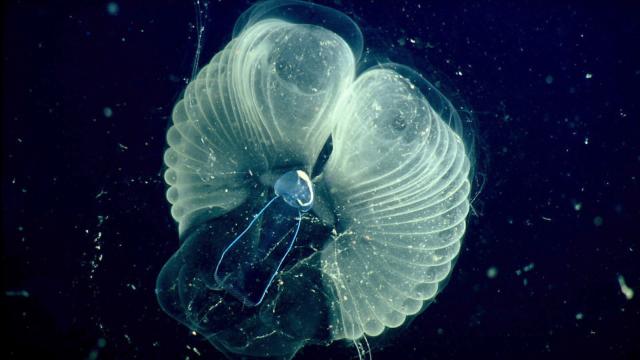Imagine the grossest home you’ve ever been to. Your beer-can littered college dorm room? The apartment of an ex-boyfriend who slept on a smelly, stained mattress on the floor? No matter what you’re thinking of, giant larvaceans’ homes probably top it.
These transparent marine invertebrates are related to plankton and look like giant tadpoles, with bulbous heads and wiggly, flat tails. They’re only about the size of a human fist, but they surround themselves with balloon-like, three-foot-wide webs of mucus that they create themselves. Scientists call the structures “snot palaces.” Disgusting? Yes. But it turns out these creatures and their gross homes serve important planetary functions, including playing an outsized role in sequestering carbon from the atmosphere.
Giant larvaceans’ snot bubbles have long been a bit of a mystery to scientists. Since they’re so delicate, bringing the bubbles into a lab isn’t feasible. So in a new study published in Nature, researchers sent a remote submarine, cameras, and lasers down 396.24 m into the waters off the coast of California to watch the larvaceans — which are related to something called “sea pork” — in their natural habitats. They were then able to reconstruct the mucus structures into a 3D model, which let them examine the structures for the first time.

“Now we have a technique for understanding the form of these complex structures, and how they function,” Kakani Katija, Monterey Bay Aquarium Research Institute principal engineer, said in a statement.
It turns snot palaces are pretty advanced structures. Giant larvaceans make one snot palace at a time, but each palace has an inner and outer chamber. The large mucus bubbles trap protects the creatures from predators while also trapping food, while the inner one acts as a filter that guides smaller morsels into its mouth. The outer mucus webs also trap tiny particles of carbon-rich plant debris, microplastics, and other detritus.
The scientists discovered that the animals make these structures by secreting mucus from cells on their heads, then blowing it up like a balloon “Whereas a spider builds a complicated web one silky strand at a time, the house of a larvacean is extruded all at once as a rudiment and is then inflated,” the study says. The process takes just an hour or so.

And it’s good thing they can make them so fast, because they’re not built to last. The fragile structures get clogged every day or two, forcing the larvaceans to build new ones. The discarded snot palaces deflate and sink, with the detritus they captured still in tow. Ordinarily, those particles could be eaten by other animals, but caught in the old snot structures, they sink to the ocean floor, away from hungry sea life. A 2017 Science Advances study found the larvaceans transfer more atmospheric carbon down to the ocean floor than any other plankton.
Now that the scientists have their observable three dimensional models of these snot palaces, they hope to learn even more about how they’re made as well as exactly how much carbon the snot palaces sink.
“Among other things, we’re hoping to understand how larvaceans build and inflate these structures,” said Katija. “This could help us design better 3D printers or build complex inflatable structures that could be used in a number of environments,” including underwater and in outer space.
They also hope to learn more about how the creatures interact with their ecosystems.
“Now that we have a way to visualise these structures deep below the surface, we can finally understand how they function and what roles they play in the ocean,” said Katija.
